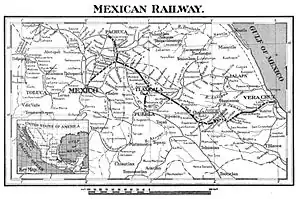| Mexican Railway | |
|---|---|
 1912 map | |
| Overview | |
| Native name | Ferrocarril México–Veracruz |
| Status |
|
| Locale | Mexico |
| Termini | |
| Service | |
| Services | 3 |
| Operator(s) | Ferrocarril Mexicano |
| History | |
| Opened | January 1, 1873 |
| Merged | March 1959 |
| Technical | |
| Line length | 679.8 km (422.4 mi) |
| Number of tracks | 1 |
| Track gauge | 1,435 mm (4 ft 8+1⁄2 in) standard gauge |
| Electrification | Partially, 103 km (64 mi), between Esperanza and Paso del Macho |
The Mexican Railway (Ferrocarril Mexicano) (reporting mark FCM) was one of the primary pre-nationalization railways of Mexico. Incorporated in London in September 1864 as the Imperial Mexican Railway (Ferrocarril Imperial Mexicano) to complete an earlier project, it was renamed in July 1867[1] after the Second French Empire withdrew from Mexico.
History

The main line from Mexico City to Veracruz was dedicated on January 1, 1873, by President Sebastián Lerdo de Tejada; branches connected Ometusco to Pachuca and Apizaco to Puebla.[2][3] The 103 kilometers (64 mi) between Esperanza and Paso del Macho were electrically operated beginning in the 1920s.[4][5]
The Mexican Railway remained independent of the government-owned Ferrocarriles Nacionales de México (National Railways of Mexico) until the government gained control in June 1946 and merged the property in March 1959.[6] Following privatization in the 1990s, Ferrosur acquired the lines of the former Mexican Railway.
References
- ↑ Pan-American Magazine and New World Review, 1923, p. 28
- ↑ Fred Wilbur Powell, The Railroads of Mexico, Stratford Company (Boston), 1921, pp. 102-103
- ↑ Manual of Statistics Company (New York), The Manual of Statistics: Stock Exchange Hand-Book, 1908, pp. 195-196
- ↑ Railway Electrical Engineer Vol 13 Number 11, pp 390-391
- ↑ Official Guide of the Railways, June 1954, pg 1191
- ↑ Tothill Press, Directory of Railway Officials & Year Book, 1961-1962, p. 272